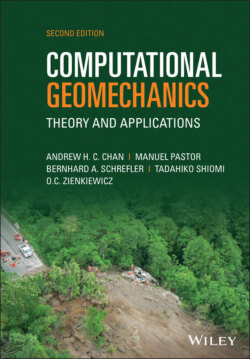Читать книгу Computational Geomechanics - Manuel Pastor - Страница 31
2.5.3 Macroscopic Balance Equations
ОглавлениеFor isothermal conditions, as here assumed, the macroscopic balance equations for mass, linear momentum, and angular momentum are then obtained by systematically applying the averaging procedures to the microscopic balance Equation (2.60) as outlined in Hassanizadeh and Gray (1979a, 1979b, 1980). The balance equations have here been specialized for a deforming porous material, where the flow of water and of moist air (mixture of dryair and vapor) is taking place (see Schrefler 1995).
The local thermodynamic equilibrium hypothesis is assumed to hold because the time scale of the modeled phenomena is substantially larger than the relaxation time required reaching equilibrium locally. The temperatures of each constituent in a generic point are hence equal. Further, the constituents are assumed to be immiscible and chemically nonreacting. All fluids are assumed to be in contact with the solid phase. As throughout this book, stress is defined as tension positive for the solid phase, while pore pressure is defined as compressively positive for the fluids.
In the averaging procedure, the volume fractions ηπ appear which are identified as follows: for solid phase ηs = 1 − n, for water ηw = nSw, and for air ηa = nSa.
The averaged macroscopic mass balance equations are given next. For the solid phase, this equation reads
(2.61)
where is the mass averaged solid phase velocity and ρπ is the intrinsic phase averaged density. The intrinsic phase averaged density ρπ is the density of the π phase averaged over the part of the control volume (Representative Elementary Volume, REV) occupied by the π phase. The phase averaged density ρπ, on the contrary, is the density of the π phase averaged over the total control volume. The relationship between the two densities is given by
(2.62)
For water, the averaged macroscopic mass balance equation reads
(2.63)
where is the quantity of water per unit time and volume, lost through evaporation and vw the mass averaged water velocity.
For air, this equation reads
(2.64)
where va is the mass averaged air velocity.
The linear momentum balance equation for the fluid phases is
(2.65)
where tπ is the partial stress tensor, ρπbπ the external momentum supply due to gravity, ρπaπ the volume density of the inertia force, the sum of the momentum supply due to averaged mass supply, and the intrinsic momentum supply due to a change of density and referred to the deviation of the velocity of constituent π from its mass averaged velocity, and accounts for exchange of momentum due to mechanical interaction with other phases. is assumed to be different from zero only for fluid phases. For the solid phase, the linear momentum balance equation is hence
(2.66)
The average angular momentum balance equation shows that for nonpolar media, the partial stress tensor is symmetric tπ ji = tπ tj at the macroscopic level also and the sum of the coupling vectors of angular momentum between the phases vanishes.
